Displaying items by tag: Norman Lee
Sailors Can Take Lead In Encouraging Growth Of Sport Says Lee
#ISA - Wicklow's Norman Lee has "very positive" feelings for the new course plotted for Irish sailing in the ISA's new strategic plan.
But the dinghy sailor echoes Afloat blogger Magheramore's comments earlier today that lasting change in the sailing scene requires real commitment from our clubs and classes.
Speaking to Afloat.ie, Lee says that "unless boat owners and other people involved in sailing actively encourage and facilitate newcomers to participate, he reorganisation will not achieve much."
Yet while Magheramore believes sailing clubs can take charge of this by changing to a 'pay for play' model whereby members would sail a club-owned fleet, potentially opening access to sailing as a sport and pastime wider than ever, Lee sees it as "one of our problems" that "too many stand back and expect the ISA or the clubs to fix things."
He suggests that sailors themselves in general could be more welcoming to newcomers, taking them out on the water "to experience the things they need to experience to get hooked."
He adds: "Most claim they are too busy or their boat isn’t suitable or they would lose points, all these selfish Tiger excuses need to be dropped if members are serious about reversing the flow and growing the sport."
Lee is also outspoken about the need for changes in club junior training, such as reducing the number of modules to save on time and costs "when all most people want is the basics so that they can safely helm or crew".
He feels strongly "that one or two seasons learning the basics should be followed immediately by channelling into normal club racing/activities. The certificate chase should only be for a few who are keen to instruct and have shown reasonable sailing ability and genuine interest in the sport."
In terms of development, Lee believes it is "good to shift the focus onto regional development officers (RDOs) getting to know the grassroots, but the job is too big for two or even three.
"Four might be okay, but only if their range of duties and job spec is kept very tight and practical. At present it seems impossible."
Overall, however, Lee maintains that the "huge work" put in over the last two years in charting a new direction for Irish sailing has been an "uplifting experience and, if it continues in the way proposed, will turn Irish sailing around and be the prototype for similar change needed in other jurisdictions."
Irish Sailing's New Strategic Plan Charts 2020 Course
#isa – Two years after a heave against the Irish Sailing Association (ISA) a new five year strategic plan has been published writes David O'Brien in this morning's Irish Times sailing column HERE.
The Plan is for the period 2015 - 2020 and is based on the views that were put to a 'Strategic Review Group'. The SRG was asked by the Board in 2013 to assess where the Association stood and how it needed to adjust to better serve the sport of Sailing. The Board accepted its Report and tasked a group to prepare a new Strategic Plan for the ISA based on its contents.
This blueprint (downoad the draft plan below as a 2mb pdf file) looks like a positive step forward not least because it makes an attempt to implement measurable targets for the good of grass–roots sailors. That rule was something lacking on a now scrapped 2020 vision document sub–titled 'grow the sport, grow the membership, grow the organisation'. This discredited plan turned out to be boom time folly and like so many other projects around the country at that time, poorly thought out and only half–built.
On foot of it, in 2013 a band of dissenting sailors held the ISA to account for its lack of performance. Back then, association efforts were more focussed on getting the ISA genie back in the bottle than the sport back on track. In a push for change at the National Yacht Club (NYC) in April 2013, the embattled body heard over 300 suggestions for change.
Not least was the fact sailing had lost a quarter of its members in recession and key yacht clubs are still in choppy financial waters. A massive fall off of junior sailors also presented an inconvenient truth that problems lay not with the children but with the paucity of guidance for newcomers.
Sailors like Norman Lee and Bryan Armstrong were joined by former president Roger Bannon (now its Treasurer) in calling for fundamental reform.
'The ISA has lost its way over the last few years," Bannon wrote in March 2013, giving his view of a bureaucracy 'detached from the reality of what is going on in the front line'.
Around the same time, County Wicklow dinghy sailor Lee said he wanted 'the ISA focus off elite sailing and the emphasis instead to be on enjoying sailing for fun as per the association's own articles of association'.
Two years on, an independent group of sailors has charted a new course but does this revised game plan satisfy these demands? Will it be a boost for clubs and classes, particularly smaller ones, or is the only comfort for them the fact that the process took place?
The underlying principle of the Plan is moving from a 'governance approach' to one of the principal stakeholders in the Sport working together with goal of encouraging and developing participation. The Association, Clubs, Training Centres, Classes and associated groups working in union to achieve those objectives underlies all of the strategies. There will be a renewed emphasis on utilising the input of volunteers to harness the skills and knowledge of active sailors so that the ISA can evolve and develop and respond to issues that arise.
The approach is in a logically presented format but there is very little that suggests the ISA will support ageing, less popular class associations, preferring rather to put faith in the bricks and mortar of clubs and training centres to strengthen access and participation avenues for current and potential sailors.
While many of the strategies are laudable, there will be difficulties in operating them, particularly where they are dependent on the vigour, enthusiasm and skills of volunteers at club level.
Indeed, there may be some instances where ISA aspirations are in direct conflict with local trends and activities. For example, what will the Optimist and Laser classes say to the strategy of 'encouraging participation of younger sailors in two person boats' or the dinghy classes about the strategy of encouraging crewing in keelboats.
The scenario will create debate about the professional structure required to deliver on its aspirations particularly in the training area. Suitably qualified personnel are necessary to negotiate the tricky waters disturbed by the demands of the multiple agencies with a stake in the sport and its delivery – HSA, Department of Transport, Department of Education.
At the same time it would appear that the working plan appears to validate the ISA's High Performance department as many of the strategies suggested are actually currently operational.
There are a number of curious omissions:
·No mention of Paralympic sailing in the High Performance section
·No mention of Youth Worlds, a fertile ground for ISA recently
·No mention of financing the association, strangely in light of the discussion around its joint membership scheme.
Where does the balance lies when gauging the benefit of an organisation producing a strategic plan – is it the outcome or the process that is the more valuable exercise? Or worse still, is it the creation of a stick to be beaten with further down the road if targets are not achieved.
The ISA has been fortunate in being able to rely on some excellent volunteer directors for the overhaul process. The combination of effectiveness and commitment of the new board has brought the association a long way in a short time but how sustainable is this voluntary effort over time?
One doer maybe better than forty talkers but effective volunteers are hard to find. Finding an ISA President a year ago was not without difficulty in itself. In the absence of such voluntary effort, and with the benefit of experience, can the professional staff see this new plan through or is more help needed?
As a draft, this document will no doubt undergo some change in the process that now follows. And while there have been some changes at the ISA's Park Road HQ, the evolution of the ISA from the Ursula Maguire administered one-person organisation of 20 years ago continues with a relatively minor correction of the set and drift that had crept in in recent years. Are more changes still to come? Will there be a replacement for the recently departed training director? Perhaps too someone is also needed to support the club racing side – maybe in conjunction with the Irish Cruiser Racing Association (ICRA)?
The appointment of Regional Development Officers to assist Clubs and Training Centres has been seen as one of the ISA success stories in recent years and it is proposed to increase their availability to Clubs and Training Centres. The Board has already decided to add a further RDO to the two existing appointments to ensure the local availability of expertise and advice and facilitate greater co-operation and coordination between local Clubs and with Training Centres.
The primary role of the Clubs in growing the sport locally, attracting newcomers and maintaining the interest of both existing and new members is acknowledged. Better linkages between Clubs and Training Centres for their mutual benefit are proposed. This is in the knowledge that most newcomers interested in taking up Sailing feel more comfortable in approaching a Training Centre than a Club but the long term involvement of sailors in the sport is best ensured by them joining Clubs, participating in Club activities and enjoying the benefits - both practical and social - that membership provides.
The over elaborate structure of ISA training courses and the difficulties of qualifying, retaining and upskilling instructors was a widespread complaint when the Review Group conducted their research. Strategies to resolve those problems are proposed.
An often expressed view about the Club Training schemes for Junior sailors is the amount of effort committed to running courses by Clubs and the relatively poor transfer rate from the courses to Club involvement and activity afloat. It is planned to refocus the training courses away from a 'certificate chase' to an emphasis on developing the skills learned. An online sailing passport scheme to supplement the paper based certificate system is proposed. It will be trialled in the coming season and will allow the recording of both course attendance and other time afloat, whether racing or leisure sailing.
A strategy of encouraging the training of young sailors in two person boats, as opposed to single handed craft, is proposed, with a view to improving both their technical and social skills. A renewed emphasis on sailing being a sport for life and avoidance of the risk of sailor burnout by compressing skills acquisition into young sailors' early teens, are envisaged.
The redressing of the perceived imbalance between the support structures for those competing in the non-Olympic area and those involved with the High Performance area - essentially the Olympic arena - is proposed. This will not affect the support for the High Performance sector, which is funded through the good offices of the Irish Sports Council, but will instead propose that the support available to other areas of competition will be enhanced. Better access for Clubs and Classes to coaching at local level is one of the principal strategies envisaged and it is hoped that Clubs and Classes will be able to access both coaches with a High Performance background and those with experience of specific Classes.
It is proposed that the ISA should re-commence the co-ordination of a racing event calendar to facilitate the avoidance of clashes between events and re-establish the balance between local, regional and national events.
Now the process of re-evaluation has begun, the ISA is urging all sailors to play a role to win back participation in sailing. A green light from clubs and classes is key to this plan's success.
The following regional meetings are taking place:
Wed 21 Jan 15 7pm-9pm Dublin, Royal St George Yacht Club
Tue 17 Feb 15 7pm-9pm Cork, Rochestown Park Hotel
Tue 24 Feb 15 7pm-9pm Galway, Galway Bay Sailing Club
Strangford Lough Sailing Secrets Revealed
#strangfordlough – Strangford Lough is one of Ireland's most important sailing locations, yet it is surprising how few sailors from other areas have savoured its unique attractions. W M Nixon tries to explain why this is so, and delves into the racing enjoyed this week by two very different classes of boats on an alluring and secret water.
Strangford Lough is a very private and hidden sort of place, whether by sea or land. Prehistoric voyagers through the Irish Sea will only have guessed and wondered at the possible existence nearby of this huge salt water lake if they happened to be near the approaches to the narrow entrance during the six hours in twelve when the ebb flows, pouring out of the lough with such vigour that the turbulence can push two or three miles out to sea. And on land, even with today's road system much of Strangford Lough remains hidden from sight.
For sure, you can have fine clear views if you happen to be driving along the road on the lough's eastern shore between Newtownwards and Kircubbin, seeing clear across the water to the lough's islands and rolling coastal hills, and beyond towards the purple peaks of the Mountains of Mourne.
But those vistas only flatter to deceive. The most intricate interaction between sea and land is largely unseen. This is along the lough's western shore, where the drumlin country which defines much of County Down becomes a remarkable pattern of sea and islands. Very occasional glimpses of the sea – inevitably with some boats moored on it in a sheltered and private looking spot – is all that the curious sightseer on land will get for his trouble.
This continually surprising if occasionally frustrating inlet is 15 nautical miles long by six miles wide. The Narrows, which feed it twice daily with a huge surge of tide from the Irish Sea, are 8 miles in length, but less than half a mile wide at their most constricted section at Bankmore Point, where the streams can run at better than eight knots and the neighbourhood whirlpool, forming just when you're thinking it doesn't really exist, is called the Routen Wheel.
While the similarly swift tides which flow through the entrance of the Morbihan in southern Brittany can become something of a small boat playground in summer, Strangford Narrows has a more serious image as the overfalls on the ebb to seaward are a much more challenging proposition. Nevertheless it's fun to sail much of it on the fair tide, and in going into the lough with the tide under you, even in ancient craft you find you're beating at better than ten knots over the ground, the VMG is jet propelled, and soon you're swooshed into a miniature cruising paradise with a myriad of islands – 365 of course - and a wide range of overnight options.
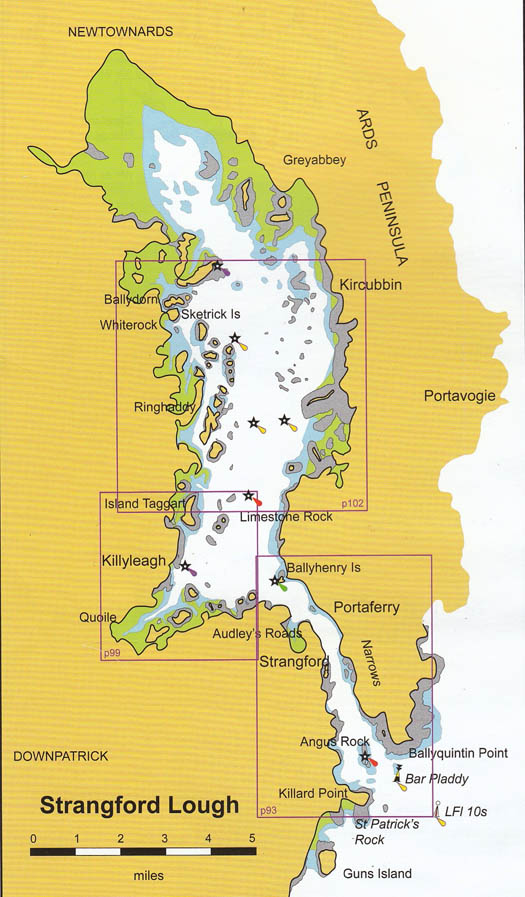
The secret place – despite its substantial size, Strangford Lough remains a mystery to a surprisingly large number of sailors. Courtesy Irish Cruising Club

Strangford Lough's western shore provides tantalising glimpses of sea and islands, usually with boats moored in a snug spot. Photo: W M Nixon
But even when you arrive at the lough by this much-preferred option of being on a boat, there's still that slight sense of intruding on a private place. While Portaferry on the east side of the narrows may present a traditional welcoming façade, and Strangford village to the west is its own charming little self, of the other towns on the lough only Kircubbin halfway up the eastern shore has anything vaguely resembling a waterfront. The lough's biggest township, Killyleagh on the west shore, may have a modern recently-developed waterfront. But that's a private enterprise thing, the town's main street is at some remove from the shore, while other urban centres in the Strangford Lough area such as Downpatrick, Killinchy, Comber, Newtownards and Greyabbey may be near the sea, but they're not of it.
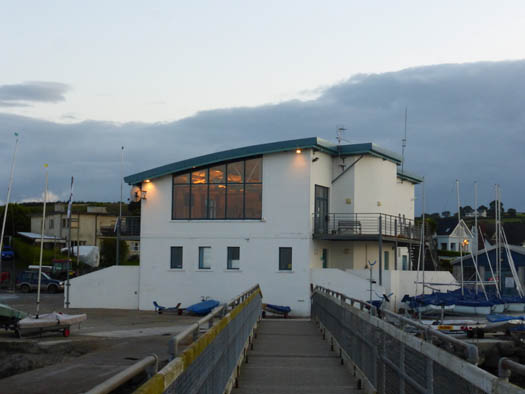
The lough's premier club is the Strangford Lough YC at Whiterock, where this "new" building has been serving members' needs for a dozen years now. Photo: W M Nixon

The view from within. Though the SLYC building may present a utilitarian appearance, its main room is successfully multi-purpose as lounge, dining room and bar, and the view from it is of a comfortable anchorage ready for sailing. Photo: W M Nixon
Yet the lough is home to hundreds of boats, serviced both by private facilities and something like eleven different boat, yacht and sailing clubs. But most of them are along that complex western shore where, in choice locations, the big landowners who had made their money in Belfast's boom days from 1850 to 1912 were so keen to preserve their privacy that they made sure there were no road signs on the few narrow public roads approaching their substantial houses near the shore.
Some years ago, there was an official attempt to liberalise this with a sprinkling of signs, but a visit this week showed that many of them had somehow disappeared, or become invisible under the verdant growth which is fundamental to this heart of the County Down. So more than a smidgin of local knowledge is needed if you wish to access the sailing in this maritime wonderland. But if you can do so, the sport is wonderful if racing around islands and in wayward yet manageable currents is your thing, while there's enough open space in mid-lough to provide a clear venue for major open events, even if it can involved a bit of a sea trek from the shore base at some hidden club.
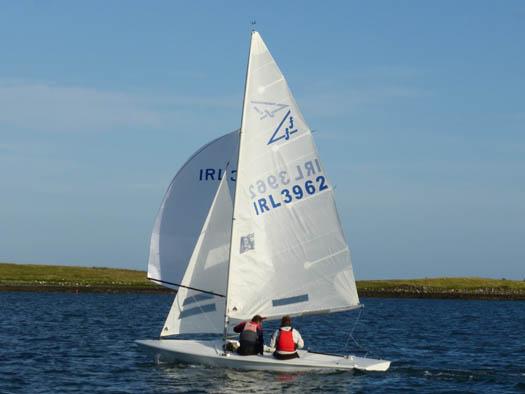
A Flying Fifteen in action at Whiterock off Strangford Lough YC, which has produced F/F Champions to world level.
The active sailing scene in Strangford Lough has produced champions to world level over the years, most notably in the Flying Fifteen class where Strangford Lough sailing surnames such as Carson, Brown, Andrews and McCann have been inscribed on the top trophies down the decades. Thus there's a sense of history in the making with this year's Irish F/F Championship being staged in six days time from August 22nd to 24th by Portaferry Sailing Club at the southeast corner of the lough, where it will be interesting to see how far north they have to go in order to get clear of the fierce tides which flow close past the club's headquarters near Portaferry Marina beside The Narrows.
Meanwhile, this week we'd the chance on Strangford Lough to suss out the racing in two classes which may seem very different, yet each emerged from a clearcut initial requirement which now seems very remote.
The River Class boats at the lough's premier club, Strangford Lough YC at Whiterock on the west shore near Killinchy, really are the area's best kept secret. This is quite an achievement in an ultra-private place like Strangford Lough. Everyone involved with the Rivers knows so much about them that they assume the rest of the world does too. But surprisingly few outsiders know that in the inner reaches of Strangford Lough, they race a class of handsome Alfred Mylne-designed 29ft one design sloops which yield to no-one for classic good looks.
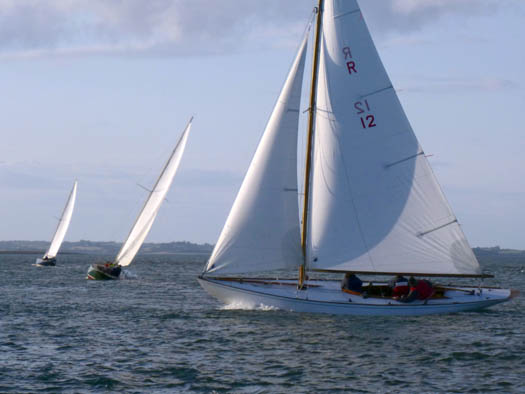
The Mylne-designed 29ft River Class combine classic good looks with real sailing power. Photo: W M Nixon
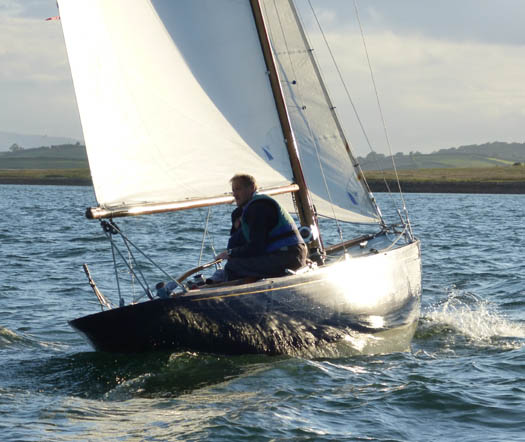
As usual, River Class champion Kenny Smyth has to look astern to see how the opposition is doing. Photo: W M Nixon
Their origins date back to 1919, when some northern sailing people started exchanging ideas about the need for an easily-handled simple sloop "which could be sailed by a man and his daughters". At first glance, this seems like a welcome and liberal requirement, fuelled by the emergence of the suffragette movement seeking votes and rights for women. But in fact, it's the bleakest design spec you ever read. The Great War of 1914-18 had resulted in the deaths of so many young men from the north of Ireland, with scores of them boat enthusiasts who had been active sailors before its outbreak, that the only way the sport could resume in any meaningful way was by moving on from the labour-intensive gaff rigs, jackyard topsails and multiple headsails of the pre war days, on into a simple rig which faced the harsh new reality.
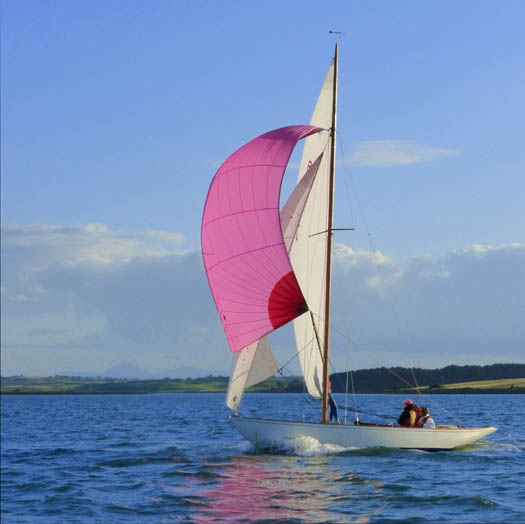
The essence of Strangford Lough – a River Class sloop sailing well, and the timeless view beyond across County Down to the Mountains of Mourne. Photo: W M Nixon

If dodging tides by going close inshore is your thing while using every little twist to the wind, then racing Rivers on Strangford Lough is just for you. Photo: W M Nixon
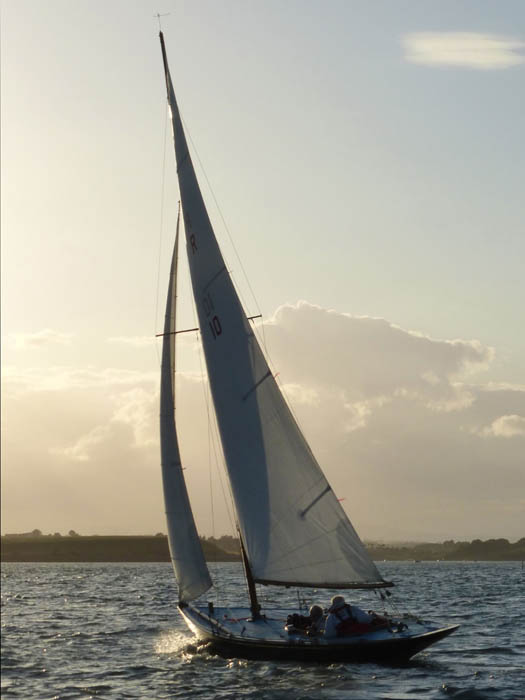
In harmony with her surroundings, a River Class sloop makes her elegant way afloat. Photo: W M Nixon
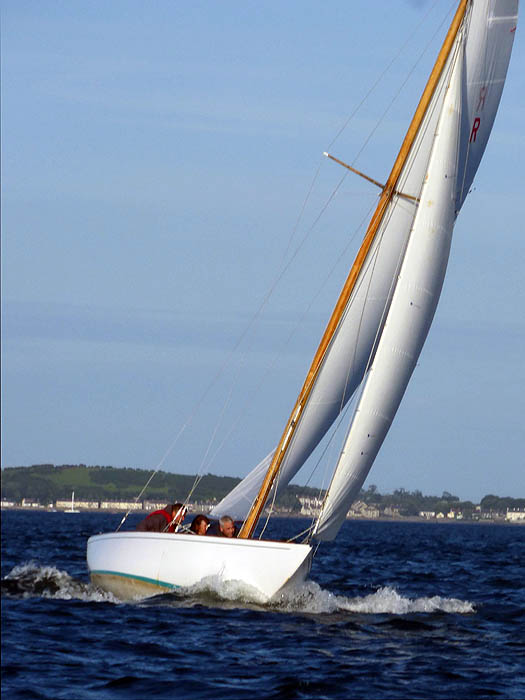
When there's a bit of bite to the breeze, it's impressive how much power the conservatively-canvassed River Class sloops can develop. Photo: W M Nixon
But though the rig may have spoken volumes – it's believed to be the first Bermudan-rigged one design – there was no way that the great Alfred Mylne, the man who reputedly drew the lines of Britannia in 1892-93 as a trainee naval architect in G L Watson's Glasgow office, was going to design anything other than a good-looking boat. Admittedy, with her cockpit well aft, there can be times when a River seems to sit on her stern if her crew are more interested in comfort than boat trim. But when she's sailing on her designed lines, she's a joy to behold, and with her heavy but harmonious hull, she can carry her way in impressive style, making tacking a nicely judged and elegant manoeuvre if it's done right.
In all, a dozen Rivers have been built, most of them before 1923, while the class started racing in 1921. At first, they shifted their racing venues between Belfast Lough and Strangford Lough, as the owners were mostly members of Royal Ulster YC at Bangor. But from time to time they liked to moor their boats off their shoreside big houses on Strangford Lough, usually with their estate gardeners being roped in for additional duties as boat delivery crews sailing between the two loughs along the often rough North Channel coast of the Ards Peninsula. The very thought of it might easily turn anyone into a firebrand revolutionary.
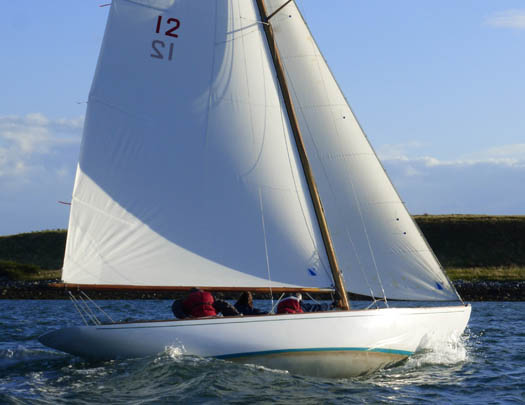
The River was designed by Alfred Mylne in 1920, and shows some family resemblance to the Mylne-designed Dublin Bay 21s (1902) and Dublin Bay 24s (1937), while still being very much an individual in her own right. Photo: W M Nixon
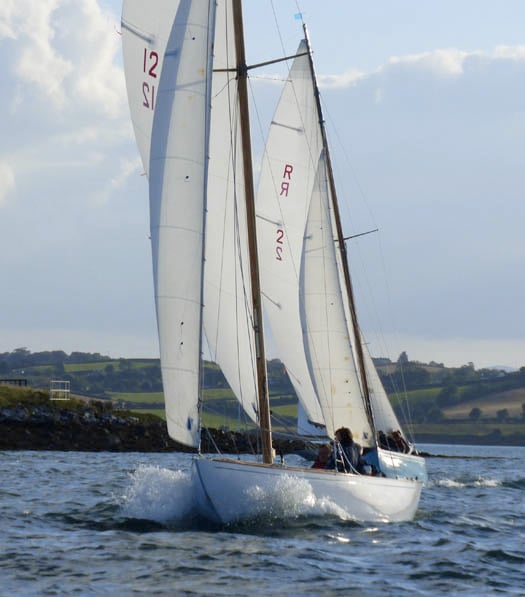
Thanks to an adequately-sized rudder of only moderate rake, it is possible to race the Rivers at close quarters with confidence. Photo: W M Nixon
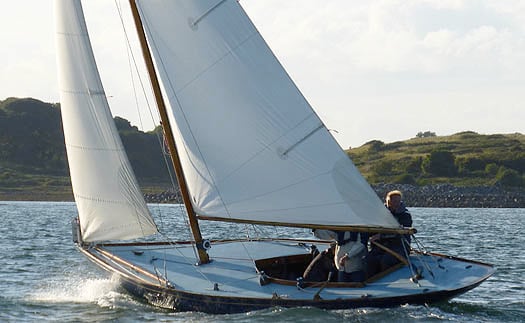
As the Rivers don't set genoas, the correct trim of the little jib is absolutely key to racing success. The class has strict rules about replacing sails only as a group in order to maintain one design performance. Photo: W M Nixon
Be that as it may, gradually the focus moved completely to Strangford Lough, and for a while the class had such a preponderance of aristocratic owners that you could be forgiven for thinking it was P G Wodehouse's take on yachting. Typical were Lord and Lady Londonderry (they pronounced its London-dree), with their seat at Mount Stewart on the lough's eastern shore.
They argued so much aboard their River that they had to get another one so that Lady Edith could race against her husband. In the late 1930s, when she began to favour a policy of Appeasement with the resurgent Germany and flirted with Hitler's Nazis, she invited the Nazi big cheese von Ribbentrop to stay at Mount Stewart and sail with her in a race off the house aboard her River, which was duly T-boned during the event by her husband in his boat.
That was about the height of international excitement and celebrity for the Rivers. By the end of the 1930s, the class had become based at Whiterock with the new Strangford Lough Yacht Club, and the only time they subsequently emerged blinking into the outside world was in 1951 when they sailed as a group to race in the Festival of Britain Regatta Week on Belfast Lough, where the supreme champion by a mile in the River racing was the young Barry Bramwell sailing his family's boat Roe. His subsequent stellar sailing career included winning many dinghy championships, and he skippered a boat for Ireland in the Admiral's Cup.

Although the River Class have not sailed outside Strangford Lough since 1951, their close competition at home has produced some notable performers in other boat types. Photo: W M Nixon
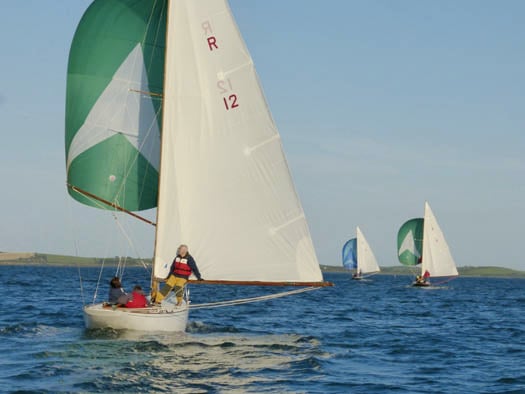
Rivers on the run, and looking very handsome with it. The class has decided that having a kicking strap would not be in the spirit of the design, so having a crewman seated on the boom on a dead run is standard practice. Photo: W M Nixon

With the crew up forward under the deck, and only the helmsman aft in the cockpit, Brian Law's Uladh (10) is perfectly trimmed for best performance to windward. Photo: W M Nixon
The Rivers meanwhile returned home after the Festival Regatta Week, and since 1951 the nearest they've ever got to the open sea is the annual visit to the time-honoured Narrows Regatta between Portaferry and Strangford for a few days in July. Otherwise, they might sometimes be seen at local regattas at the Quoile, Killyleagh and Kircubbin. But for the most part, they stay in stately seclusion at Whiterock and enjoy a compact annual racing programme. This may seem to be only relatively few races to those from other hyper-keen local one design classes. But after 93 years, the Rivers have become such an integral part of the fabric of sailing at Whiterock, and such a central part of community and family life for those involved, that you don't need a huge number of races for each season to be a success, what's needed is the savouring of the moments afloat on a summer's evening, and then an analysis of each race in loving detail in the friendly clubhouse afterwards.
With the GP 14 Worlds coming up on Strangford Lough this past week, there was an ideal opportunity to contrast two forms of sailing there. I'd already tried to get some River Class photos on an evening earlier in the season by signing up to sail as fifth hand aboard Brian Law's Uladh (the von Ribbentrop boat). But when we all assembled, it emerged - in typically Strangford Lough style - that the helmsman was delayed by the need to get his wife and daughter's vintage horsebox through its MOT test, so I was stuck on the Tiller That Von Ribbentrop Held.
Despite that, the boat was a joy to sail in a light summery shirt sleeves breeze, but it resulted in damn all worthwhile photos on the disk. So this week, Brian and another River owner Kenny Smyth, Vice Commodore SLYC, arranged for Chris Boston, whose hobby is being a sort of Honorary Boatman at Whiterock, to take me out to buzz around the racing fleet on an August evening with a decent though fading northwest breeze, and Chris did a super job.
My camera is just a clever little Lumix, which is a Leica lens with a sort of digital Box Brownie stuck on the back. So please excuse the fuzzy telephoto shots, but the photos speak for themselves – the Rivers are good looking classic boats which provide great sport. These days, the Smyth brothers Kenny and Graham are setting the pace, which suggests sailing enthusiasm of a high order. Their day job is running the characterful little boatyard immediately south of Whiterock, an establishment created by their legendary father Billy who introduced his family to cruising through extensive ventures in the former Manx fishing boat Aigh Vie (see this blog on 29th March 2014). Whatever way Billy Smyth did it, he imbued his sons with such enthusiasm that they can spend their working day being busy fixing somebody else's boat, then go out and sail their own boats with equal dedication in the weekly evening race. And they're more than generous with helpful tips to their opponents on tactics and tuning.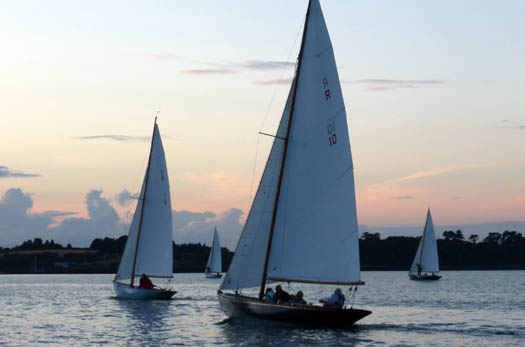
When they talk of "twilight racing" in the River Class, they really mean it......Photo: W M Nixon
Having spent an entertaing and very complete evening with the classics that were designed so that they could be sailed by a man and his daughters, next morning found me contemplating a hundred dinghies to a 14ft design which was originally envisaged as a useful and versatile little boat to provide "affordable fun afloat for Pa, Ma and the kids".
Like the River, the GP 14 emerged in a post war situation, but in 1949 the mood after World War II (1939-45) was much more egalitarian than it had been in 1919. The General Purpose 14 was the brainchild of Teddy Haylock, the Editor of Yachting World magazine in London, and it was one of the first in a series which became the YW Build Her Yourself boats, mostly designed by Jack Holt with DIY plywood kits supplied by Bell Woodworking Co.
Haylock still carried his wartime title of Group Captain E F Haylock after a "good war" with the RAF, but he had a very clearcut view of how things should go in peacetime. If his projects sometimes seemed to be delivered in a slightly patronising tone, there's no doubt his heart was in the right place, even if some of his posher advertisers weren't at all pleased by his glossy magazine devoting so much energy to people who hoped to self-assemble their own boats rather than buy a complete and expensive one from an established yacht builder.
To say that the GP 14 succeeded beyond anyone's wildest dreams is under-stating the case. Though the 14,000-plus boats built worldwide have been used for general purposes, they're primarily racing boats these days, and it was this which brought a hundred of them to the well hidden East Down YC in behind Island Taggart on Strangford Lough's west shore just north of Killyleagh.
Back in 1970, most folk thought that just about every possible sailing club site on the shores of Strangford Lough had been earmarked and developed. But the founders of EDYC discovered this place, which was accessible by land only along a narrow unpaved track going so close to the edge of a farmyard that it almost goes through it. In those days before 4X4s were ubiquitous, you really did need a Landrover to get to the new waterfront location with any certainty. But over the years the club has expanded its clubhouse and its facilities ashore with an extensive dinghy park, while the keelboat fleet linked to the club includes former Commodore Jay Colville's First 40 which took part in this year's ICRA Nats in Dun Laoghaire.
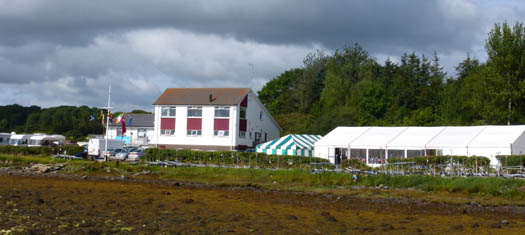
East Down YC, venue for the GP 14 Worlds 2014. Photo: W M Nixon

Somehow or other, the founders of EDYC in 1970 managed to shoehorn their substantial clubhouse with its large dinghy park into a previously unused waterfront setting accessed via this narrow lane. Photo: W M Nixon
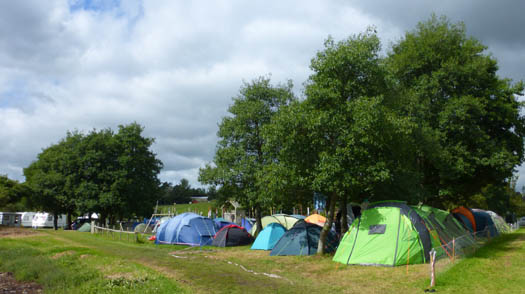
All that GP 14 sailors require is somewhere to pitch their tent........Photo: W M Nixon
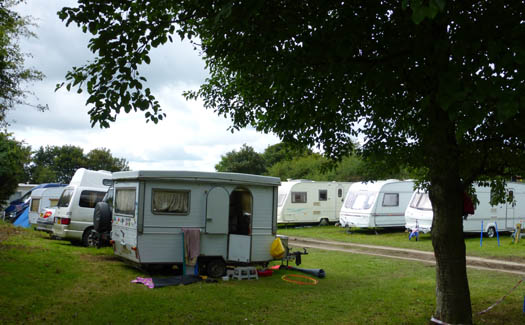
...or park their 'van. Photo: W M Nixon

Graham Wright of EDYC gallantly took on the challenge of chairing the Organising Committee for the GP 14 Worlds 2014 with just two years to go to the off. Photo: W M Nixon

The kind of headlines that any organisers dread. Yet EDYC were quite rightly so confident about their proper handling of the weather problems that they subsequently displayed this newspaper spread in the main marque. Photo: W M Nixon
Taking on a Worlds is a formidable challenge for any club, and when it's the Worlds of a dinghy class which is as important in Ireland as the GP 14, the pressure is greater still. It was as recently as 2012 that East Down was approached by the Irish GP 14 Association as they realised other avenues were being closed off in their search for a willing club for their allocated staging of the Worlds in 2014, and the club deserves an award for courage in taking it on, setting up an Organising Committee under Graham Wright and getting the show on the road.
I'd a telling instance of just why the GP 14 is so relevant recently while heading through Youghal, where three dinghy masts were visible above a harbourside wall. On the other side of the wall was one of those little mud-filled docks which are such a feature of Youghal's waterfront, and sitting serenely on the mud were three GP 14s.
What else could they have been? As I was to discover at EDYC, the GP 14 is central to building up the sailing club at Youghal, and at many other clubs all round the country too. While some members may try more glamorous boats from time to time, the GP 14 ticks most boxes in terms of versatility while setting a spinnaker, having an effective class structure, and providing racing at all levels.
My own links to the class go back to the 1960s when the sailing club at Queens University in Belfast suddenly found itself supplied with funds for a new boat or two provided the boats were built within a specified time. Although club captain, I was already a dedicated keelboat man except for the annual foray into Fireflies racing against other colleges in Dun Laoghaire and England & Wales. In other words, I knew nothing. However, our Honorary Secretary Mike Balmforth was a very switched on guy who had built his own Enterprise with his father. But as QUB already had a couple of old GP 14s, he soon decided that we could get the boats built on time – and they'd be GP 14s as required - by a relative newcomer to boatbuilding called Gerry Duffin, a former housebuilder and carpenter who had his workshop in East Belfast and was starting to fulfil his dream of building boats.
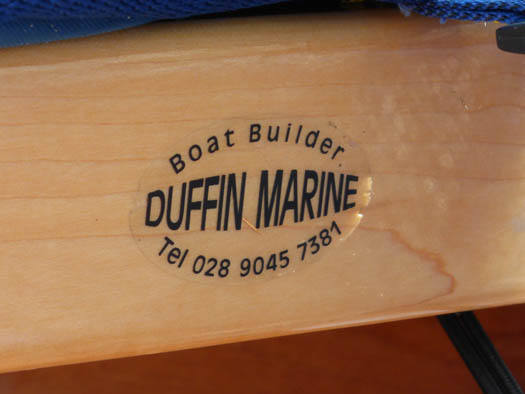
The sign of success – the home firm builds the best GP 14s in the world. Photo: W M Nixon
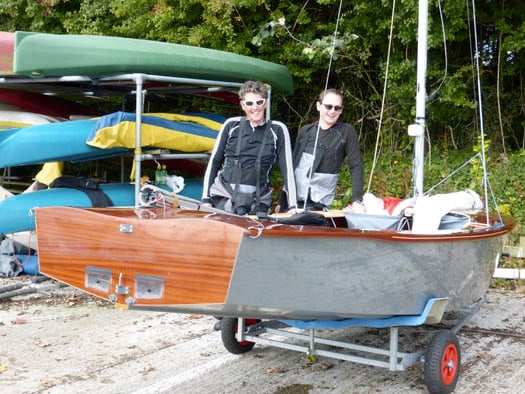
The "Duffin dip" in the transom of the newest boat for the Lough Foyle fleet. Photo: W M Nixon
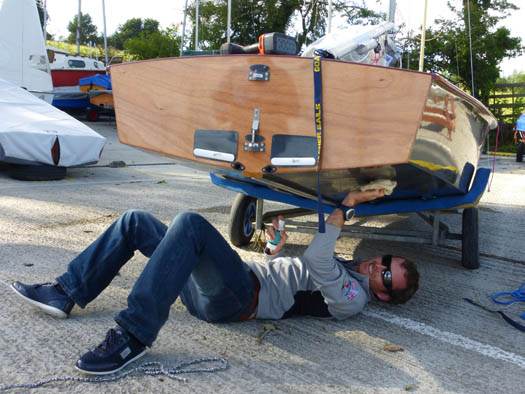
"If you want to be sure it's done properly, then you have to do it yourself" Top contender Ian Dobson putting in some work on the hull finish. Photo: W M Nixon
One rainy day we went across town in Mike's rickety Austin 7 (its wooden frame was supported by Spanish windlasses utilising electric cable instead of rope), and there in the shed was the first of the new boats. It was a very old shed, and there were several leaks which prompted Gerry to quip that he really should get the builders in. But to our young eyes, there was nothing to see but this lovely new GP 14, an early product of a line which continues to the present day, for at East Down YC this week all the main contenders, and indeed the majority of the fleet, were Duffin built, with Duffin Marine for many years now being run by Gerry's son Alistair.
Like the Smyth brothers up at Whiterock, his enthusiasm is almost certifiable, as he not only builds the best GP 14s for everyone else, but he also races keenly with the class. And though the rules are strict, he is always trying to find ways of innovating his products, which are more like collector's furniture than boats.
In recent years, he has tried to persuade the class to let him take out most of the transom in modern style, but when an open transom was declared verboten, instead he introduced the "Duffin dip" in the afterdeck. When asked why, his answer was that he just keeps trying to reduce weight. Whatever, people certainly love his boats. I was at East Down briefly in late afternoon on the layday on Wednesday, and though there were few folk around, down at the end of the dinghy park was top contender Ian Southworth beavering away at his beloved Duffin boat.
The mood was distinctly relaxed with the club and the class well recovered from he unexpected wall-to-wall attention they'd received on the Monday. A couple of nasty squalls – yet another by-product of the slow progress of former Hurricane Bertha across northwest Europe – had resulted in between ten and twenty boats having some difficulty in coping with being capsized. But the Championship safety team were handling it competently when it was declared an Emergency Situation by some Powers That Be. Almost immediately those narrow roads and single track approaches to the club were jammed with ambulances and a fire brigade as helicopters gyrated overhead.
While some newspapers sought only to have shock headlines, it has to be said that when the scale of the over-response became evident, it was heartening to see how the better strands of the media responded to it all with an intelligent and friendly interest in what was going on. They were fascinated by how an event which was classed as a World Championship was being staged, and staged so effectively too, at the end of a tree-lined single-track lane in remotely rural County Down. In the end, the clear egalitarian nature of GP 14 racing and the calmness of the people involved reflected very well on the image of our sport. And as for the multiple rescue and emergency services, they had all the benefits of a "for real" exercise which might prove to be very useful in the unlikely event of a passenger jetliner ever coming down among the islands of Strangford Lough.
The atmosphere may have been serene in the late afternoon of the layday, but next morning with three races scheduled in a brisk nor'wester, the club compound was hectic enough for anyone. And the layday did the trick – as one of the International Jury remarked, it is very unusual at any Worlds to see the entire fleet put to sea two thirds of the way into the event, but they poured down the slip and away out round the island, and at the end of it there wasn't a boat left ashore.
But by that time I'd had every opportunity to observe the spirit of the GP 14s, and it is formidable. Ireland has a great record in the class, with Bill Whisker of Ballyholme becoming a World Champion, while others like Paul Rowan of East Antrim and Pat Murphy of Clontarf were in the international frame for years.
Yet these days the class is as keen as ever in encouraging new blood and establishing a firm foothold at new clubs. That glimpse of a nascent GP 14 class at Youghal well illustrated the point, and it was Norman Lee who told the story. I'd spotted the famous vintage camper van which is the campaign base for GP 14 legend Norman Lee of Greystones, who is crewed by his brother Ken and supported by Norman's wife Una and their two collie dogs - dogs on campaign are very much a GP 14 thing.
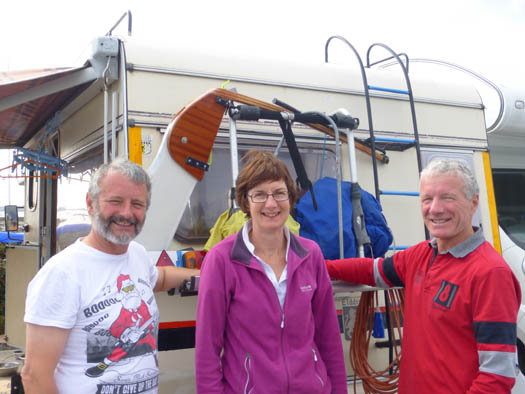
The Lee team from Greystones with their vintage campervan are Ken (left), Norman (right) and Una. Photo: W M Nixon
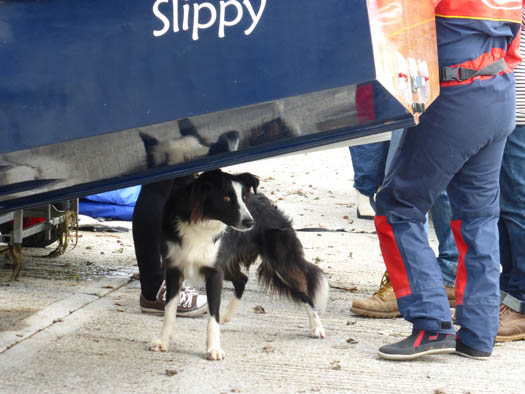
If you're going to have a GP 14.........Photo: W M Nixon
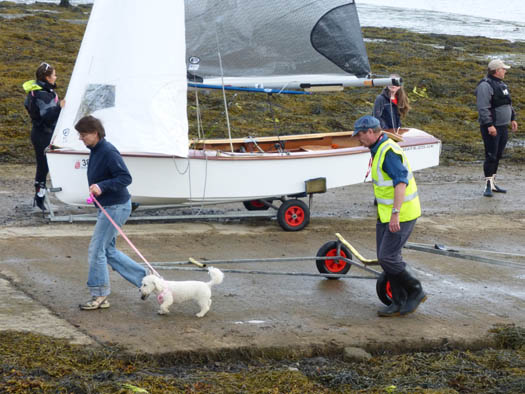
....then you have to have a pooch. Photo: W M Nixon

...and while most breeds are allowed, a collie variant is preferred. Photo: W M Nixon
The Lee equipage was in fine form, having taken a useful second in one of Tuesday's races, but as soon as I mentioned the presence of the Geeps at Youghal, all that was forgotten as Norman enthused about the growing club there, and what he and the class are doing to get Youghal's GP fan Adrian Lee (no relation) and his group further down the road.
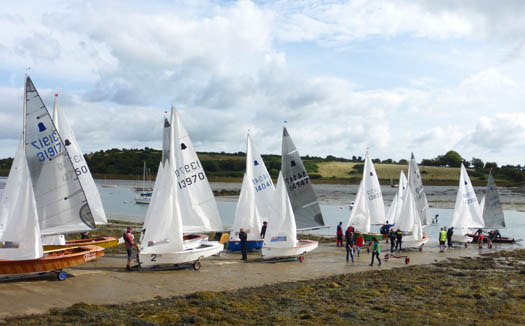
Getting a hunded boats away is a formidable challenge..... Photo: W M Nixon
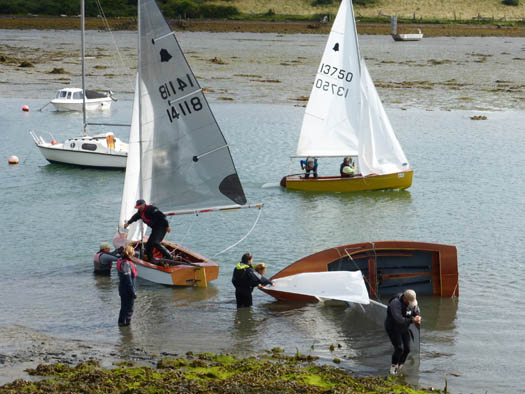
....and the last thing you need is somebody deciding last minute adjustments are essential.......Photo: W M Nixon

....when they're still joining the queue at the top of slip. Photo: W M Nixon
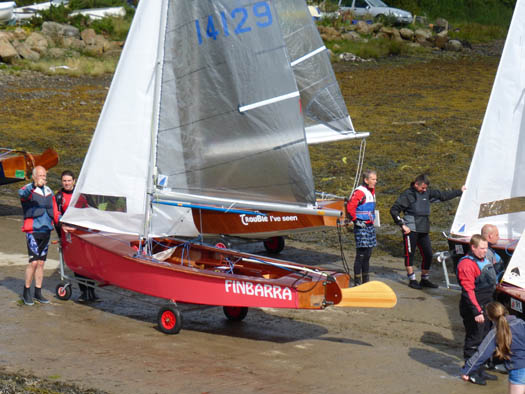
"Don't these guys holding us up realise that they're delaying a whole line of renowned international athletes.....?" Photo: W M Nixon
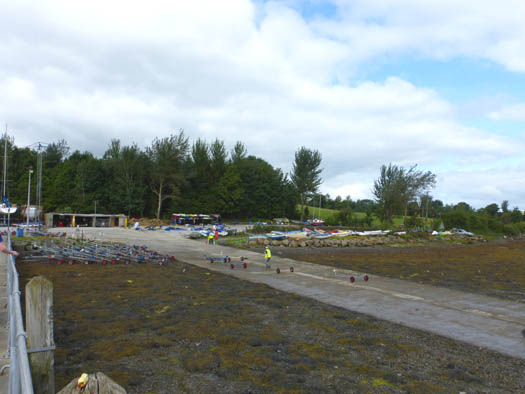
Suddenly, they're gone – every last one of them. This is one very keen class. Photo: W M Nixon
Or more accurately, further up the river. Norman and other GP 14 sailors are fascinated by the possibilities of the mighty Blackwater River which reaches the sea at Youghal. Already, they have had a trial distance sail from the estuary right up to Cappoquin, and this has fired them up so much that they're going to make it a major event when they repeat it in the last weekend of August in order to give Youghal SC a proper re-launch. Their enthusiasm has so fired up others that top GP 14 racers like Ger Owens from Dun Laoghaire have said they'll go, as have crews from the growing fleets on Lough Foyle, which is wellnigh as far as it's possible to be from Youghal without leaving Ireland.
It may all seem a bit far-fetched. But believe me, when you're in a large dinghy park at the end of a small farm track in the depths of County Down, and when the event photographer has just gone aloft in a small aircraft because that's the best way to get snaps of a major dinghy event out in the middle of Strangford Lough, then long distance dinghy sailing events from Youghal to Cappoquin seem eminently feasible.


























































